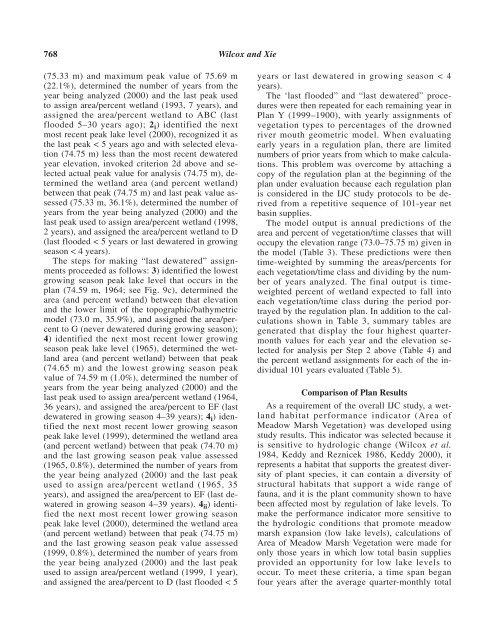Predicting Wetland Plant Community Responses to ... - BioOne
Predicting Wetland Plant Community Responses to ... - BioOne
Predicting Wetland Plant Community Responses to ... - BioOne
You also want an ePaper? Increase the reach of your titles
YUMPU automatically turns print PDFs into web optimized ePapers that Google loves.
768 Wilcox and Xie<br />
(75.33 m) and maximum peak value of 75.69 m<br />
(22.1%), determined the number of years from the<br />
year being analyzed (2000) and the last peak used<br />
<strong>to</strong> assign area/percent wetland (1993, 7 years), and<br />
assigned the area/percent wetland <strong>to</strong> ABC (last<br />
flooded 5–30 years ago); 2 i ) identified the next<br />
most recent peak lake level (2000), recognized it as<br />
the last peak < 5 years ago and with selected elevation<br />
(74.75 m) less than the most recent dewatered<br />
year elevation, invoked criterion 2d above and selected<br />
actual peak value for analysis (74.75 m), determined<br />
the wetland area (and percent wetland)<br />
between that peak (74.75 m) and last peak value assessed<br />
(75.33 m, 36.1%), determined the number of<br />
years from the year being analyzed (2000) and the<br />
last peak used <strong>to</strong> assign area/percent wetland (1998,<br />
2 years), and assigned the area/percent wetland <strong>to</strong> D<br />
(last flooded < 5 years or last dewatered in growing<br />
season < 4 years).<br />
The steps for making “last dewatered” assignments<br />
proceeded as follows: 3) identified the lowest<br />
growing season peak lake level that occurs in the<br />
plan (74.59 m, 1964; see Fig. 9c), determined the<br />
area (and percent wetland) between that elevation<br />
and the lower limit of the <strong>to</strong>pographic/bathymetric<br />
model (73.0 m, 35.9%), and assigned the area/percent<br />
<strong>to</strong> G (never dewatered during growing season);<br />
4) identified the next most recent lower growing<br />
season peak lake level (1965), determined the wetland<br />
area (and percent wetland) between that peak<br />
(74.65 m) and the lowest growing season peak<br />
value of 74.59 m (1.0%), determined the number of<br />
years from the year being analyzed (2000) and the<br />
last peak used <strong>to</strong> assign area/percent wetland (1964,<br />
36 years), and assigned the area/percent <strong>to</strong> EF (last<br />
dewatered in growing season 4–39 years); 4 i ) identified<br />
the next most recent lower growing season<br />
peak lake level (1999), determined the wetland area<br />
(and percent wetland) between that peak (74.70 m)<br />
and the last growing season peak value assessed<br />
(1965, 0.8%), determined the number of years from<br />
the year being analyzed (2000) and the last peak<br />
used <strong>to</strong> assign area/percent wetland (1965, 35<br />
years), and assigned the area/percent <strong>to</strong> EF (last dewatered<br />
in growing season 4–39 years). 4 ii ) identified<br />
the next most recent lower growing season<br />
peak lake level (2000), determined the wetland area<br />
(and percent wetland) between that peak (74.75 m)<br />
and the last growing season peak value assessed<br />
(1999, 0.8%), determined the number of years from<br />
the year being analyzed (2000) and the last peak<br />
used <strong>to</strong> assign area/percent wetland (1999, 1 year),<br />
and assigned the area/percent <strong>to</strong> D (last flooded < 5<br />
years or last dewatered in growing season < 4<br />
years).<br />
The ‘last flooded” and “last dewatered” procedures<br />
were then repeated for each remaining year in<br />
Plan Y (1999–1900), with yearly assignments of<br />
vegetation types <strong>to</strong> percentages of the drowned<br />
river mouth geometric model. When evaluating<br />
early years in a regulation plan, there are limited<br />
numbers of prior years from which <strong>to</strong> make calculations.<br />
This problem was overcome by attaching a<br />
copy of the regulation plan at the beginning of the<br />
plan under evaluation because each regulation plan<br />
is considered in the IJC study pro<strong>to</strong>cols <strong>to</strong> be derived<br />
from a repetitive sequence of 101-year net<br />
basin supplies.<br />
The model output is annual predictions of the<br />
area and percent of vegetation/time classes that will<br />
occupy the elevation range (73.0–75.75 m) given in<br />
the model (Table 3). These predictions were then<br />
time-weighted by summing the areas/percents for<br />
each vegetation/time class and dividing by the number<br />
of years analyzed. The final output is timeweighted<br />
percent of wetland expected <strong>to</strong> fall in<strong>to</strong><br />
each vegetation/time class during the period portrayed<br />
by the regulation plan. In addition <strong>to</strong> the calculations<br />
shown in Table 3, summary tables are<br />
generated that display the four highest quartermonth<br />
values for each year and the elevation selected<br />
for analysis per Step 2 above (Table 4) and<br />
the percent wetland assignments for each of the individual<br />
101 years evaluated (Table 5).<br />
Comparison of Plan Results<br />
As a requirement of the overall IJC study, a wetland<br />
habitat performance indica<strong>to</strong>r (Area of<br />
Meadow Marsh Vegetation) was developed using<br />
study results. This indica<strong>to</strong>r was selected because it<br />
is sensitive <strong>to</strong> hydrologic change (Wilcox et al.<br />
1984, Keddy and Reznicek 1986, Keddy 2000), it<br />
represents a habitat that supports the greatest diversity<br />
of plant species, it can contain a diversity of<br />
structural habitats that support a wide range of<br />
fauna, and it is the plant community shown <strong>to</strong> have<br />
been affected most by regulation of lake levels. To<br />
make the performance indica<strong>to</strong>r more sensitive <strong>to</strong><br />
the hydrologic conditions that promote meadow<br />
marsh expansion (low lake levels), calculations of<br />
Area of Meadow Marsh Vegetation were made for<br />
only those years in which low <strong>to</strong>tal basin supplies<br />
provided an opportunity for low lake levels <strong>to</strong><br />
occur. To meet these criteria, a time span began<br />
four years after the average quarter-monthly <strong>to</strong>tal
















